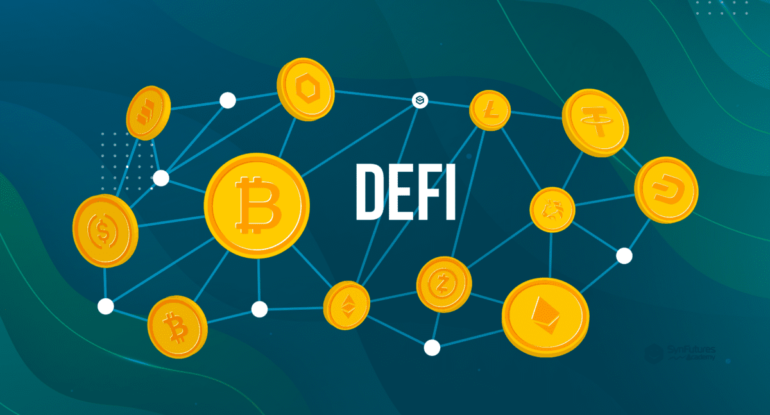Your Go To Guide To DeFi Liquidations And How They Work

Decentralized Finance (DeFi) has transformed the traditional financial landscape, offering users the opportunity to engage in various financial activities without intermediaries. However, with great potential comes inherent risks, and one significant aspect that requires attention is DeFi liquidations. In this comprehensive guide, we will delve into what DeFi liquidations are, why they occur, and how users can monitor and mitigate associated risks.
Understanding DeFi Liquidations

In the DeFi space, liquidations occur when a user’s collateral falls below a specified threshold, triggering an automated process to liquidate their assets. This is often linked to lending protocols, where users lock up collateral to borrow assets. If the value of the collateral drops significantly, the protocol may liquidate a portion or all of the collateral to repay the borrowed funds and prevent default.
Common Causes of DeFi Liquidations

DeFi liquidations are triggered by specific events or conditions that affect the collateral-to-debt ratio, leading to the need for automatic asset liquidation to protect lenders and the stability of the platform. Here’s an in-depth exploration of common causes of DeFi liquidations:
1. Market Volatility:
- Issue: High volatility in cryptocurrency markets can cause rapid and significant price changes.
- Impact: Sudden and substantial price drops can lead to a decrease in the value of collateral, breaching the predefined collateralization ratio and triggering liquidation.
2. Overcollateralization Issues:
- Issue: Users may not adequately maintain the required collateral-to-debt ratio.
- Impact: If the collateral value falls below the agreed-upon threshold, it can trigger liquidation even if market conditions are relatively stable.
3. Flash Loan Attacks:
- Issue: Flash loans allow users to borrow large sums of assets without providing collateral, provided the borrowed amount is returned within the same transaction.
- Impact: In a flash loan attack, a user can manipulate the market or exploit vulnerabilities in a DeFi protocol, potentially leading to mass liquidations across the platform.
4. Oracle Manipulation:
- Issue: Price oracles provide data on the market value of assets. Manipulating these oracles can misrepresent the actual value of collateral.
- Impact: False or manipulated price data can trigger inaccurate liquidations, either prematurely or without adequate cause, affecting the overall integrity of the DeFi system.
5. Leveraged Positions:
- Issue: Users might take highly leveraged positions, borrowing large amounts relative to their collateral.
- Impact: A slight price movement against leveraged positions can result in the collateral’s value falling below the required threshold, leading to liquidation.
6. Interest Rate Changes:
- Issue: Variable interest rates can change based on market conditions or protocol parameters.
- Impact: If interest rates increase significantly, borrowers may struggle to cover the higher costs, potentially leading to liquidations if the collateral-to-debt ratio is affected.
7. Smart Contract Bugs or Exploits:
- Issue: Bugs or vulnerabilities in smart contracts can be exploited by malicious actors.
- Impact: Exploits can lead to unexpected behavior, including unauthorized withdrawals or changes to collateral values, potentially triggering mass liquidations.
8. Collateral Asset Illiquidity:
- Issue: Some assets used as collateral may have low liquidity.
- Impact: In times of market stress, illiquid assets can experience significant price slippage, exacerbating the risk of liquidation.
9. Systemic Risk:
- Issue: External events, such as regulatory changes or macroeconomic shifts, can introduce systemic risk to the cryptocurrency market.
- Impact: These events can trigger market-wide volatility, affecting the value of collateral across various assets and potentially leading to widespread liquidations.
10. Network Congestion:
- Issue: High transaction volumes and network congestion can result in delays in liquidation processes.
- Impact: Delays in executing liquidations can expose platforms to additional risks, especially during periods of rapid market movements.
Understanding these common causes is essential for users and developers involved in decentralized finance. It emphasizes the importance of risk management strategies, continuous monitoring, and the development of robust smart contracts to ensure the resilience and security of DeFi platforms in the face of dynamic market conditions and potential vulnerabilities.
I wrote a comprehensive article about liquidations in DeFi with @cal_nix.
In it, we detail how different liquidation systems work.
Whether you are a novice and you want to know more, or you are a veteran and want to fill in the gaps, there is something in it for all of you.🧵…
— alcueca (@alcueca) November 14, 2023
How DeFi Liquidations Work

DeFi liquidations are a critical mechanism in decentralized finance platforms that help maintain the stability and integrity of the system. The process involves the automatic sale of collateral when a borrower’s position becomes too risky, ensuring that lenders are protected and the platform remains solvent. Let’s delve into the detailed workings of how DeFi liquidations operate:
1. Collateralized Borrowing:
- DeFi platforms enable users to borrow assets by depositing collateral, creating a collateralized debt position (CDP).
- Borrowers lock up a certain amount of cryptocurrency as collateral to obtain a loan in another asset.
2. Collateral-to-Debt Ratio:
- The collateral-to-debt ratio is a crucial parameter, representing the relationship between the value of the collateral and the borrowed amount.
- This ratio determines the level of risk associated with the position.
3. Thresholds and Liquidation Triggers:
- DeFi platforms set collateralization thresholds. If the collateral-to-debt ratio falls below a certain level, it triggers the liquidation process.
- The threshold is designed to ensure that lenders have sufficient collateral to cover potential losses.
4. Price Oracles:
- DeFi platforms rely on price oracles, which are external data sources providing real-time market prices of assets.
- Oracles feed price information into smart contracts, enabling the system to assess the current value of the collateral.
5. Smart Contracts:
- Smart contracts govern the entire borrowing and liquidation process.
- When the collateral-to-debt ratio breaches the predefined threshold, the smart contract automatically initiates the liquidation process.
6. Liquidation Auctions:
- The smart contract triggers a liquidation auction, where the collateral is put up for sale.
- Users interested in acquiring the collateral participate in the auction by placing bids using stablecoins.
7. Auction Duration and Mechanics:
- Liquidation auctions are time-limited to minimize exposure to price volatility. Shorter durations enhance the efficiency of the liquidation process.
- The highest bidder within the specified time frame wins the auction.
8. Debt Repayment:
- The stablecoins obtained from the winning bid are used to repay the outstanding debt of the liquidated position.
- This ensures that lenders are compensated for the potential loss in the value of the borrowed assets.
9. Excess Funds:
- If the winning bid exceeds the debt amount, the excess funds are returned to the liquidated user.
- This provides a level of compensation to the user whose position was liquidated.
10. Market Dynamics:
- The auction price is determined by market dynamics and the bidding process.
- In times of extreme market volatility, there may be slippage, where the auction price deviates from the oracle price.
11. User Risk Mitigation:
- Users engaged in DeFi activities often implement risk mitigation strategies. This can include maintaining a buffer of collateral above the minimum requirement to avoid liquidation.
12. Continuous Monitoring:
- Both users and the platform must continuously monitor market conditions, collateral values, and the overall health of the DeFi ecosystem.
- Rapid responses to changing conditions help prevent or mitigate potential liquidation risks.
13. Ensuring System Solvency:
- The entire liquidation process is designed to ensure the solvency of the DeFi platform by maintaining appropriate collateralization levels and protecting lenders from losses.
In summary, the functioning of DeFi liquidations involves a combination of smart contracts, price oracles, and a competitive auction process. It is a dynamic and automated system that aims to balance efficiency, fairness, and risk mitigation in the ever-changing landscape of decentralized finance.
Also, read – Tracking Progress From NFTs To DeFi That Are Expanding The World Of Blockchain Projects
Monitoring DeFi Liquidations

Monitoring DeFi liquidations is crucial for users and platforms to ensure the stability, security, and efficient functioning of decentralized finance systems. Continuous monitoring helps detect potential risks, prevent liquidation events, and allows for prompt reactions to market dynamics. Here’s a detailed exploration of how monitoring DeFi liquidations works:
1. Collateral-to-Debt Ratio Monitoring:
- Users and platforms regularly monitor the collateral-to-debt ratio of individual positions.
- Automated systems track this ratio in real-time, comparing the current value of collateral to the outstanding debt.
2. Thresholds and Risk Parameters:
- Platforms set collateralization thresholds and risk parameters based on the specific characteristics of the assets involved.
- Monitoring involves regularly checking if the collateral-to-debt ratio approaches or breaches these predefined thresholds.
3. Price Oracle Integration:
- Price oracles provide accurate and up-to-date market prices of assets.
- Integrated with smart contracts, these oracles feed data to the system, allowing it to assess the current value of the collateral and make informed decisions.
4. Automated Smart Contracts:
- Smart contracts play a pivotal role in the automated monitoring process.
- These contracts are programmed to execute actions, such as triggering liquidations, when certain conditions, like breaching collateralization thresholds, are met.
5. Real-Time Data Feeds:
- DeFi platforms use real-time data feeds to ensure that price information is current and accurate.
- Continuous data updates from oracles contribute to effective monitoring and timely decision-making.
6. Alert Systems:
- Automated alert systems are employed to notify users and platform administrators of critical events.
- Alerts can be triggered when the collateral-to-debt ratio nears or breaches predefined thresholds, allowing for swift action.
7. User Interface Dashboards:
- Users are provided with intuitive dashboards that display the status of their positions.
- Visual representations of collateralization levels and historical data help users make informed decisions.
8. Historical Analysis:
- Platforms often incorporate historical data analysis to identify patterns and trends.
- Historical performance data aids in predicting potential risks and understanding the impact of specific market conditions on collateral values.
9. Risk Management Tools:
- Users are equipped with risk management tools that allow them to simulate the impact of various scenarios on their positions.
- These tools help users make informed decisions about adjusting collateral or repayments.
10. Community Monitoring:
- The decentralized nature of DeFi often involves community monitoring.
- Users may actively participate in governance and decision-making processes related to risk parameters, ensuring a collective effort in monitoring the system.
11. Liquidity Pools Monitoring:
- Platforms monitor the liquidity of assets and stablecoins in pools to ensure that liquidations can be efficiently carried out.
- Adequate liquidity reduces the risk of slippage during liquidation auctions.
12. Emergency Response Plans:
- Platforms have predefined emergency response plans in place.
- These plans outline procedures to follow in the event of extreme market conditions or unexpected events to mitigate the impact of potential liquidations.
13. Educational Resources:
- Platforms provide educational resources to users, helping them understand the risks involved and how to monitor their positions effectively.
- Informed users are better equipped to manage their DeFi activities and avoid unnecessary liquidations.
14. External Audits:
- Periodic external audits by reputable firms help ensure the security and reliability of the DeFi platform.
- Audits assess the effectiveness of monitoring systems and the overall robustness of the smart contracts.
In summary, monitoring DeFi liquidations involves a combination of real-time data feeds, automated systems, user interfaces, and community engagement. It is an ongoing process that requires proactive measures to detect and mitigate potential risks, ensuring the continued health and stability of the decentralized finance ecosystem.
Mitigating DeFi Liquidation Risks

Mitigating DeFi liquidation risks is crucial to ensure the stability and security of decentralized finance platforms. Users and platforms employ various strategies and tools to minimize the potential impact of liquidation events. Here’s a detailed exploration of how DeFi liquidation risks are mitigated:
1. Risk Management Strategies:
- Overcollateralization: Users often maintain a buffer of collateral above the minimum required to reduce the risk of sudden liquidation.
- Diversification: Diversifying collateral across different assets can mitigate the impact of price volatility in a specific asset.
2. Continuous Monitoring:
- Regularly monitoring the collateral-to-debt ratio and market conditions is fundamental.
- Automated systems and alert mechanisms help users and platforms stay informed in real-time.
3. Utilization of Risk Parameters:
- Platforms set risk parameters, including collateralization thresholds, based on careful analysis of asset characteristics.
- Adhering to these parameters helps in preventing risky positions and unnecessary liquidations.
4. Dynamic Collateralization Models:
- Some platforms implement dynamic collateralization models that adjust the collateral requirement based on market conditions.
- This adaptive approach helps in responding to changing risk profiles.
5. Flash Loan Protections:
- Platforms may implement safeguards against flash loan attacks by imposing restrictions on the size or duration of flash loans.
- These measures reduce the risk of sudden and large-scale liquidations.
6. Insurance Protocols:
- Insurance protocols within DeFi ecosystems offer coverage against potential losses due to liquidations.
- Users can purchase insurance to protect their collateral and borrowed assets.
7. Decentralized Governance:
- Platforms often involve users in governance processes.
- Community members can participate in decisions related to risk parameters, helping ensure a collective and diversified approach to risk management.
8. Emergency Shutdown Mechanisms:
- Some platforms implement emergency shutdown mechanisms that can be triggered in extreme situations.
- This allows for a controlled and orderly liquidation process, reducing the risk of panic-induced market behavior.
9. Use of Stablecoins:
- Borrowing stablecoins as opposed to volatile assets can reduce the risk of liquidation.
- Stablecoins are less susceptible to price volatility, providing a more stable base for collateral.
10. Liquidity Management:
- Platforms actively manage liquidity pools to ensure that assets are available for liquidation auctions.
- Adequate liquidity reduces the risk of slippage during the auction process.
11. Educational Resources:
- Platforms provide educational resources to users, helping them understand the risks associated with DeFi and how to use risk management tools effectively.
- Informed users are better equipped to make prudent decisions.
12. Risk Simulation Tools:
- Users have access to risk simulation tools that allow them to model the impact of various scenarios on their positions.
- These tools help users understand potential risks and make informed decisions about managing their collateral.
13. Smart Contract Audits:
- Regular external audits of smart contracts by reputable firms help identify vulnerabilities and ensure the security of the platform.
- Audits contribute to building trust among users and reducing the risk of exploits leading to liquidations.
14. Market Research and Analysis:
- Both users and platforms engage in continuous market research and analysis.
- Understanding broader market trends and factors influencing asset prices contributes to effective risk management.
15. Compliance with Regulatory Standards:
- Platforms may adhere to regulatory standards to mitigate legal and regulatory risks.
- Compliance contributes to the overall risk management framework.
In summary, mitigating DeFi liquidation risks involves a combination of user strategies, platform protocols, and industry best practices. A holistic and proactive approach is essential to ensure the resilience and sustainability of decentralized finance ecosystems in the face of dynamic market conditions.
Conclusion
DeFi liquidations are an inherent aspect of the decentralized financial ecosystem. While they present risks, proactive monitoring, and risk management strategies can help users navigate and mitigate these challenges effectively. By staying informed, diversifying collateral, and employing conservative borrowing practices, participants can engage in DeFi activities with a reduced risk of liquidation events. As the DeFi space continues to evolve, users must remain vigilant and adapt their strategies to maintain a secure and sustainable financial position.


























































